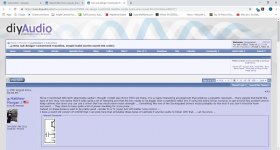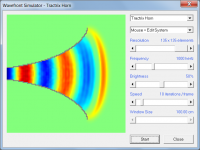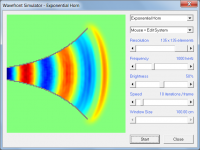RCA-Fan mentioned a "C-path" horn he did a couple of years ago where a small reflector at the first bend made things worse.
here's the old/bulky University Classic vs Jim Mosher's 2-12 corner horn which less bulk at one watt nominal drive
(M151 has a rather low 4.8 ohm Re figure for an 8 ohm driver)

here's the old/bulky University Classic vs Jim Mosher's 2-12 corner horn which less bulk at one watt nominal drive
(M151 has a rather low 4.8 ohm Re figure for an 8 ohm driver)

You could also configure the driver setting for two drivers and simply double the areas....
Yes, I tried doubling the area of horn and doubling some of the driver parameters, but stopped that approach because I had a hard time keeping things coordinated. I would forget which parameters were doubled or divided by two and then get the wrong simulations.
Bruce Edgar did work on optimal reflectors for bass horns, his finding was that 45 degree reflectors are better than curved reflectors. Have you seen his articles about the Showhorn and the Monolith? ....
No, I had not seen these articles before, but have a copy of each now. It's certainly something to think about. Thanks for the recommendation. 🙂
Jim
Last edited:
....here's the old/bulky University Classic vs Jim Mosher's 2-12 corner horn which less bulk at one watt nominal drive
(M151 has a rather low 4.8 ohm Re figure for an 8 ohm driver)....
I notice that the basic K-horn volume is still less than the University speaker, and has more low end, albeit at slightly lower efficiency.
Jim.
Hi all
I did simply stack 2 khorns im the corner. That also doubles everything. In sizes, throat, mouth, diameter etc. It did double the output by 6dB. It did significantly smoothen the response. While keeping the low frequency extension just the same. Pretty much like simulating a bigger horn.
Just that stacking two is easier than reinventing the wheel.
I also saw a wavefront simulation by another guy once (dont have it on hand srry) regarding foldings. May have been ABEC. Comparing a U shape horn. Once round snail like a western. Once edgy, with two 90° folds. And once edgy with said 45° reflectors.
While pure edgy was slightly worse than snail, it was actually the reflectors that clearly outperformed both significantly. The whole shape of the wavefront was much more even and symmetrical and defined. While the snail was ragged wavy asymmetrical. This was only considering the visual shape of the waves. No response. But goes well along with many findings in history and with Bruce Edgars.
By the way. I’ve read earlier here about improving the rubber band throat. I see a correlation to the research of oblate spheroid waveguide. Isn’t a fast expanding throat lowering nonlinear distortion?
It may be, just to linearize 1dB lowend (which is rugged by the room ten times worse anyhow) , eliminating the rubber band throat may bring us more distortion, especially D2.
Cheers
JosH
I did simply stack 2 khorns im the corner. That also doubles everything. In sizes, throat, mouth, diameter etc. It did double the output by 6dB. It did significantly smoothen the response. While keeping the low frequency extension just the same. Pretty much like simulating a bigger horn.
Just that stacking two is easier than reinventing the wheel.
I also saw a wavefront simulation by another guy once (dont have it on hand srry) regarding foldings. May have been ABEC. Comparing a U shape horn. Once round snail like a western. Once edgy, with two 90° folds. And once edgy with said 45° reflectors.
While pure edgy was slightly worse than snail, it was actually the reflectors that clearly outperformed both significantly. The whole shape of the wavefront was much more even and symmetrical and defined. While the snail was ragged wavy asymmetrical. This was only considering the visual shape of the waves. No response. But goes well along with many findings in history and with Bruce Edgars.
By the way. I’ve read earlier here about improving the rubber band throat. I see a correlation to the research of oblate spheroid waveguide. Isn’t a fast expanding throat lowering nonlinear distortion?
It may be, just to linearize 1dB lowend (which is rugged by the room ten times worse anyhow) , eliminating the rubber band throat may bring us more distortion, especially D2.
Cheers
JosH
Last edited:
Yes, I tried doubling the area of horn and doubling some of the driver parameters, but stopped that approach because I had a hard time keeping things coordinated. I would forget which parameters were doubled or divided by two and then get the wrong simulations.
FYI, FWIW: Ron E graciously shared his DVC wiring and driver modeler Excel SS with us many moons ago to resolve this seeming ~universal dilemma 😉:
https://www.diyaudio.com/forums/sub...ple-build-series-tuned-6th-8.html#post4034171
GM
FYI, FWIW: Ron E graciously shared his DVC wiring and driver modeler Excel SS with us many moons ago to resolve this seeming ~universal dilemma 😉:
https://www.diyaudio.com/forums/sub...ple-build-series-tuned-6th-8.html#post4034171
GM
Hi GM,
Did you include the link as a source to Ron E Excell SS? I looked through the posts in close proximity your link and did not see a post by Ron E.
Jim.
???? My link takes you right to the post [one of mine] with the zip files.
GM
Hi GM,
The link....
diyaudio.com\forums\subwoofers\259509-sub-design-constricted-transflex-simple-build-series-tuned-6th-8.html#post4034171
.....takes me to the location above.
I changed the slashes to backslashes so that I could post this without having the link scrambled.
If I hover over your link, it shows the same location on DIYaudio, as listed above.
Jim.
.....Have you seen his articles about the Showhorn and the Monolith?......
I just found this fantastic article about Bruce Edgar. One of Bruce's colleagues interviewed him. It's one of the most articulate articles I have read on horn loudspeakers. Spent the last two hours highlighting areas of the text.
Thanks again Ivo for the reference to Mr. Edgar!
Jim.
Attachments
Hi GM,
The link....
diyaudio.com\forums\subwoofers\259509-sub-design-constricted-transflex-simple-build-series-tuned-6th-8.html#post4034171
.....takes me to the location above.
I changed the slashes to backslashes so that I could post this without having the link scrambled.
If I hover over your link, it shows the same location on DIYaudio, as listed above.
Jim.
Scrambled? Copy/pasting a link doesn't scramble it. Anyway, when I use your link I see the two attached zip files in my post, so what are you seeing?
GM
.....so what are you seeing?....GM
I see a post from Matthew Morgan, as below, and no zip files.
Jim
Attachments
Interesting! AFAIK I've never messed with changing anything WRT viewing, etc., or if I even can, but on my pg. 8 my post is #392! Also, I've done these kinds of linking plenty of times without any issues, so wonder why yours is hundreds away.
Sure would like to know why.......
Anyway, might as well post them here too or are these 'buggered'/bogus too?:
https://www.diyaudio.com/forums/att...x-simple-build-series-tuned-6th-dvcpublic-zip
https://www.diyaudio.com/forums/att...build-series-tuned-6th-drivermodel_public-zip
GM
Sure would like to know why.......
Anyway, might as well post them here too or are these 'buggered'/bogus too?:
https://www.diyaudio.com/forums/att...x-simple-build-series-tuned-6th-dvcpublic-zip
https://www.diyaudio.com/forums/att...build-series-tuned-6th-drivermodel_public-zip
GM
It's one of the most articulate articles I have read on horn loudspeakers.
Articulate yes, but not strictly correct in parts 🙂.
For example, to quote from the article:
"When the plane waves travel down to the end of the mouth of an exponential horn, suddenly there is a bulge where they exit into space, and that bulge is essentially a discontinuity. So you have reflections at the mouth, which travel back to the throat and set up a quarter-wavelength resonance condition. With the Tractrix horn, since the waves are spherical going through the horn, they exit the mouth with very few reflections."
The wavefronts in an exponential horn are curved, not planar, and the reflections from the mouth are much the same for both the exponential and tractrix profiles.
Attachment 1 shows the wavefronts in a full-mouth (90 degrees) tractrix horn.
Attachment 2 shows the wavefronts in an equivalent-sized exponential horn.
The reason given in the article for choosing the tractrix profile over the exponential profile, would seem to be based on a false premise...
Attachments
....Anyway, might as well post them here too or are these 'buggered'/bogus too?:.....GM
Hi GM,
Hey, those links worked!
Thanks for the files. 🙂
Jim.
....The reason given in the article for choosing the tractrix profile over the exponential profile, would seem to be based on a false premise...
Hi David,
Thanks for the clarification! The two graphs do show that the exponential and tractrix shapes are very close indeed.🙂
Jim.
Last edited:
Mixed Metaphors
Horn design for low frequency horns has an entirely different priority set than that of their high frequency counterparts. Here we a dealing with the former.
1) Neither of these horns emit 1-p spherical waves. This is not a particularly relevant fact nor are these designs by themselves, optimal.
2) The well organized forward propagation shown, becomes modularly chaotic in a frequency dependent manner, when back waves resulting from mouth reflectance are superimposed. In a properly designed corner horn, this is a trivial issue as well.
3) Never the less, in this regard, the tractrix horn, of the same overall dimensions, will exhibit slightly less reflectance. But so what, we are radiating out of a room corner which is the only approach that works for any LF horn that can be moved through a reasonably sized domestic doorway.
4) For corner horns, adjoining room boundary conditions must be included in the simulation if you want some modicum of accuracy in the resulting performance prediction.
5) In this setting, the junction between the horn body and the room should be treated as a discontinuity in the acoustic pathway(s).
6) If the horn body extends from floor to ceiling in a typical room corner, then waves traveling away from it may be considered 1-p and of circular cylindrical shape. This is about as ideal as it is going to get and only if two room corners are available to meet crossover requirements to the complimentary HF horn units.
WHG
Articulate yes, but not strictly correct in parts 🙂.
For example, to quote from the article:
"When the plane waves travel down to the end of the mouth of an exponential horn, suddenly there is a bulge where they exit into space, and that bulge is essentially a discontinuity. So you have reflections at the mouth, which travel back to the throat and set up a quarter-wavelength resonance condition. With the Tractrix horn, since the waves are spherical going through the horn, they exit the mouth with very few reflections."
The wavefronts in an exponential horn are curved, not planar, and the reflections from the mouth are much the same for both the exponential and tractrix profiles.
Attachment 1 shows the wavefronts in a full-mouth (90 degrees) tractrix horn.
Attachment 2 shows the wavefronts in an equivalent-sized exponential horn.
The reason given in the article for choosing the tractrix profile over the exponential profile, would seem to be based on a false premise...
Horn design for low frequency horns has an entirely different priority set than that of their high frequency counterparts. Here we a dealing with the former.
1) Neither of these horns emit 1-p spherical waves. This is not a particularly relevant fact nor are these designs by themselves, optimal.
2) The well organized forward propagation shown, becomes modularly chaotic in a frequency dependent manner, when back waves resulting from mouth reflectance are superimposed. In a properly designed corner horn, this is a trivial issue as well.
3) Never the less, in this regard, the tractrix horn, of the same overall dimensions, will exhibit slightly less reflectance. But so what, we are radiating out of a room corner which is the only approach that works for any LF horn that can be moved through a reasonably sized domestic doorway.
4) For corner horns, adjoining room boundary conditions must be included in the simulation if you want some modicum of accuracy in the resulting performance prediction.
5) In this setting, the junction between the horn body and the room should be treated as a discontinuity in the acoustic pathway(s).
6) If the horn body extends from floor to ceiling in a typical room corner, then waves traveling away from it may be considered 1-p and of circular cylindrical shape. This is about as ideal as it is going to get and only if two room corners are available to meet crossover requirements to the complimentary HF horn units.
WHG
Last edited:
Horn design for low frequency horns has an entirely different priority set than that of their high frequency counterparts. Here we a dealing with the former....WHG
Hi Bill,
I understand a portion of what you are saying by your points above, and know that this thread is primarily about low frequency corner horns.
I still appreciated David's comments above about the closeness in acoustic response of a large exponential compared to a large tractrix. I find the discussion of horns fascinating, and I have been interested in them for many years. Obviously, the horns that David is referring to are meant for some type of mid-range application, and not applicable to a bass horn. A corner bass horn mouth size is always smaller than one wavelength, and most of the time, smaller than 1/4 wavelength.
Jim.
Horn design for low frequency horns has an entirely different priority set than that of their high frequency counterparts. Here we a dealing with the former.
Hi Bill,
The reason I posted was because I was surprised to see in the article, Dr Edgar's statement that an exponential horn propagates plane waves. This thinking seemed to play a significant part in his decision to use the tractrix profile. My apologies for temporarily "hijacking" the thread - I had assumed that I would be on pretty safe ground in doing so, because the interview with Dr Edgar was posted by Jim, the originator of the thread 🙂.
Kind regards,
David
raison d'être
Hi David,
I was simply reinforcing your statement,
"Articulate yes, but not strictly correct in parts 🙂.",
which is way too generous when discussing 'real' bass horns suitable for indoor domestic venues.
The tread for the outdoor venue seems to have
dried up since my Échos post.
Regards,
Bill
Hi Bill,
The reason I posted was because I was surprised to see in the article, Dr Edgar's statement that an exponential horn propagates plane waves. This thinking seemed to play a significant part in his decision to use the tractrix profile. My apologies for temporarily "hijacking" the thread - I had assumed that I would be on pretty safe ground in doing so, because the interview with Dr Edgar was posted by Jim, the originator of the thread 🙂.
Kind regards,
David
Hi David,
I was simply reinforcing your statement,
"Articulate yes, but not strictly correct in parts 🙂.",
which is way too generous when discussing 'real' bass horns suitable for indoor domestic venues.
The tread for the outdoor venue seems to have
dried up since my Échos post.
Regards,
Bill
Alternatives
Look upon the K-Horn as the 'throat' of a much larger horn formed by the adjoining room walls. Here, room size rules. Some novel non-Klipsch designs are attached.
Regards,
Bill
Hi Jim,Hi Bill,
I understand a portion of what you are saying by your points above, and know that this thread is primarily about low frequency corner horns.
I still appreciated David's comments above about the closeness in acoustic response of a large exponential compared to a large tractrix. I find the discussion of horns fascinating, and I have been interested in them for many years. Obviously, the horns that David is referring to are meant for some type of mid-range application, and not applicable to a bass horn. A corner bass horn mouth size is always smaller than one wavelength, and most of the time, smaller than 1/4 wavelength.
Jim.
Look upon the K-Horn as the 'throat' of a much larger horn formed by the adjoining room walls. Here, room size rules. Some novel non-Klipsch designs are attached.
Regards,
Bill
Attachments
- Status
- Not open for further replies.
- Home
- Loudspeakers
- Subwoofers
- Klipsch Bass Horn Acoustic Analysis


